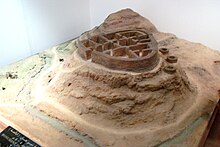Tin Hinan Tomb
The Tin Hinan Tomb (French: Tombeau de Tin Hinan) is a monumental tomb located at Abalessa in the Sahara, in the Hoggar Mountains of southern Algeria.[2] The sepulchre was built for the Tuareg matriarchTin Hinan, an ancient Queen of the Hoggar (Ahaggar). The tomb is believed to have been constructed over a Roman fortification, which was built by the proconsul Lucius Cornelius Balbus the Younger during the reign of the Roman Emperor Augustus (r. 63 BC–14 AD).

Tomb of Tin Hinan miniature at the Bardo Museum in Algiers.
|
|
| Location | Abalessa, Algeria |
|---|---|
| Type | monumental tomb |
| Beginning date | Reign of RomanEmperor Augustus (63 BC–14 AD) |
| Completion date | 1,500 years ago[1] |
| Dedicated to | Queen Tin Hinan |
HistoryEdit
According to Henri Lhote, the Tin Hinan sepulchre is different from the surrounding tombs in southern Algeria, and is more typical of the architecture used by the Roman legionaries to create their fortifications in desert areas. He believes that the tomb was therefore likely built on top of an earlier Roman castrum, which was originally erected around 19 BC, when consul Lucius Cornelius Balbus conquered the Garamantian territories and sent a small expeditionary force to reach the Niger river.[3]
Pliny, the Roman historian, wrote of a Roman raid deep into the Sahara led by Cornelius Balbus. One of the places he captured was called “Balsa” (may be the ancient name for actual Abalessa). As soon as the Romans had left, their fortification would be useless to the native rulers: they had no immediate enemies here in the heart of the Sahara desert. But such an impressive building would make a fitting tomb for their great Queen Tin Hinan, some centuries later. According to Byron Khun Prorok, the Tin Hinan tomb’s walls were around three feet thick at the highest remaining point, with the walls of the smaller tombs from eighteen inches to two feet in density. The edifice’s outer walls of the tomb also likely occupied an area of sixty by ninety feet.
Gabriel Camps in 1965 pinpointed that the stones (even more than 3 feet thick) used in the tomb were much too heavy to be moved by desert men on the hill where they are now, and this indicates clearly that the builders were not locals but “foreigners”.[4]
Furthermore, the Romans returned to the area when emperor Septimius Severus defeated again the Garamantian Kingdom around 205 AD and attempted the creation of the Roman province of Phasania (approximately actual Fezzan and surroundings). Information about this tentative is not extensive, but it is known that Romans wanted to control the trans-Saharan commerce and probably favoured the settlement of their traders and people in order to control the region. Some Romanised Berbers moved in those years from the coast to this area, and Tin Hinan (and/or her parents) could have been one of them.
Tin Hinan is the name given by the Tuareg to a 3rd- or 4th-century woman of prestige whose skeleton was found in a pre-Islamic tomb in the Ahaggar Mountains. The name means literally “She of the tents”, but may be metaphorically translated as “Mother of the tribe” (or “of us all”) or even “Queen of the camp” (the “camp” maybe referring to the group of tombs which surround hers).[5] She is sometimes referred to as “Queen of the Hoggar”, and by the Tuareg as Tamenukalt which also means “leader” or “queen”.
The tomb was opened by Byron Khun de Prorok with support from the French army in 1925, and other archaeologists made a more thorough investigation in 1933. It was found to contain the skeleton of a woman on a wooden litter, lying on her back with her head facing east. She was accompanied by heavy gold and silver jewellery, some of it adorned with pearls. On her right forearm she wore 7 silver bracelets, and on her left, 7 gold bracelets. Another silver bracelet and a gold ring were placed with the body. Remains of a complex piecework necklace of gold and pearls (real and artificial) were also present[6]Furthermore, a number of funerary objectswere also found. These included a “Venus” statue in Aurignacian style (similar to the Venus of Hohle Fels), a glass goblet (lost during World War II), and gold foil which bore the imprint of a Roman coin of emperor Constantine I issued between 308 and 324 AD. A fourth century date is consistent with radiocarbon dating of the wooden bed, as well as with the style of pottery and other tomb furniture. The monument itself is constructed in an architectural style that was widespread in the Berber Sahara during classical times.
In the 1960s, the anthropologist E. Leblanc examined the skeleton within the Tin Hinan tomb. He observed that the fossil was tall and lithe, with a narrow pelvis, broad shoulders and slender legs. Overall, the skeleton closely resembled those found in the pharaonic monuments
Hinan was a 4th-century Tuareg queen and matriarch. Her monumental tomb is located in the Sahara, at Abalessa in the Hoggar region of Algeria.
| Tin Hinan | |
|---|---|
| Tamenukalt | |

The Queen Tin Hinan, by Hocine Ziani, Oil painting, 125x150cm
|
|
| Reign | 4th-century |
| Burial | Tin Hinan tom |
Queen of the Hoggar
Tin Hinan is sometimes referred to as “Queen of the Hoggar”, and by the Tuareg as Tamenukalt which also means “leader” or “queen”. The name means literally “she of the tents”, but may be metaphorically translated as “mother of the tribe” (or “of us all”) or even “queen of the camp” (the “camp” maybe referring to the group of tombs which surround hers).
Not far from the oasis of Abalessa, Algeria, about 1,000 miles south of Algiers, a rounded hill rises about 125 ft above the junction of two wadis. The Tomb of Tin Hinan is on the summit. The ruin is pear-shaped on plan with a major axis of about 88 ft. It contains 11 room or courts.
The tomb of Tin Hinan was opened by Byron Khun de Prorok with support from the French army in 1925, and archaeologists made a more thorough investigation in 1933. It was found to contain the skeleton of a woman (probably buried in the fourth century AD) on a wooden litter, lying on her back with her head facing east. She was accompanied by heavy gold and silver jewellery, some of it adorned with pearls. On her right forearm she wore 7 silver bracelets, and on her left, 7 gold bracelets. Another silver bracelet and a gold ring were placed with the body. Remains of a complex piecework necklace of gold and pearls (real and artificial) were also present.
A number of funerary objects were also
Tin Hinan Tomb
The Tin Hinan Tomb (French: Tombeau de Tin Hinan) is a monumental tomb located at Abalessa in the Sahara, in the Hoggar Mountains of southern Algeria.[2] The sepulchre was built for the Tuareg matriarchTin Hinan, an ancient Queen of the Hoggar (Ahaggar). The tomb is believed to have been constructed over a Roman fortification, which was built by the proconsul Lucius Cornelius Balbus the Younger during the reign of the Roman Emperor Augustus (r. 63 BC–14 AD).

Tomb of Tin Hinan miniature at the Bardo Museum in Algiers.
|
|
| Location | Abalessa, Algeria |
|---|---|
| Type | monumental tomb |
| Beginning date | Reign of RomanEmperor Augustus (63 BC–14 AD) |
| Completion date | 1,500 years ago[1] |
| Dedicated to | Queen Tin Hinan |
HistoryEdit
According to Henri Lhote, the Tin Hinan sepulchre is different from the surrounding tombs in southern Algeria, and is more typical of the architecture used by the Roman legionaries to create their fortifications in desert areas. He believes that the tomb was therefore likely built on top of an earlier Roman castrum, which was originally erected around 19 BC, when consul Lucius Cornelius Balbus conquered the Garamantian territories and sent a small expeditionary force to reach the Niger river.[3]
Pliny, the Roman historian, wrote of a Roman raid deep into the Sahara led by Cornelius Balbus. One of the places he captured was called “Balsa” (may be the ancient name for actual Abalessa). As soon as the Romans had left, their fortification would be useless to the native rulers: they had no immediate enemies here in the heart of the Sahara desert. But such an impressive building would make a fitting tomb for their great Queen Tin Hinan, some centuries later. According to Byron Khun Prorok, the Tin Hinan tomb’s walls were around three feet thick at the highest remaining point, with the walls of the smaller tombs from eighteen inches to two feet in density. The edifice’s outer walls of the tomb also likely occupied an area of sixty by ninety feet.
Gabriel Camps in 1965 pinpointed that the stones (even more than 3 feet thick) used in the tomb were much too heavy to be moved by desert men on the hill where they are now, and this indicates clearly that the builders were not locals but “foreigners”.[4]
Furthermore, the Romans returned to the area when emperor Septimius Severus defeated again the Garamantian Kingdom around 205 AD and attempted the creation of the Roman province of Phasania (approximately actual Fezzan and surroundings). Information about this tentative is not extensive, but it is known that Romans wanted to control the trans-Saharan commerce and probably favoured the settlement of their traders and people in order to control the region. Some Romanised Berbers moved in those years from the coast to this area, and Tin Hinan (and/or her parents) could have been one of them.
Tin Hinan is the name given by the Tuareg to a 3rd- or 4th-century woman of prestige whose skeleton was found in a pre-Islamic tomb in the Ahaggar Mountains. The name means literally “She of the tents”, but may be metaphorically translated as “Mother of the tribe” (or “of us all”) or even “Queen of the camp” (the “camp” maybe referring to the group of tombs which surround hers).[5] She is sometimes referred to as “Queen of the Hoggar”, and by the Tuareg as Tamenukalt which also means “leader” or “queen”.
The tomb was opened by Byron Khun de Prorok with support from the French army in 1925, and other archaeologists made a more thorough investigation in 1933. It was found to contain the skeleton of a woman on a wooden litter, lying on her back with her head facing east. She was accompanied by heavy gold and silver jewellery, some of it adorned with pearls. On her right forearm she wore 7 silver bracelets, and on her left, 7 gold bracelets. Another silver bracelet and a gold ring were placed with the body. Remains of a complex piecework necklace of gold and pearls (real and artificial) were also present[6]Furthermore, a number of funerary objectswere also found. These included a “Venus” statue in Aurignacian style (similar to the Venus of Hohle Fels), a glass goblet (lost during World War II), and gold foil which bore the imprint of a Roman coin of emperor Constantine I issued between 308 and 324 AD. A fourth century date is consistent with radiocarbon dating of the wooden bed, as well as with the style of pottery and other tomb furniture. The monument itself is constructed in an architectural style that was widespread in the Berber Sahara during classical times.
In the 1960s, the anthropologist E. Leblanc examined the skeleton within the Tin Hinan tomb. He observed that the fossil was tall and lithe, with a narrow pelvis, broad shoulders and slender legs. Overall, the skeleton closely resembled those found in the pharaonic monuments
found. These included a “Venus” statue in Aurignacian style (similar to the Venus of Hohle Fels), a glass goblet (lost during World War II), barbed arrowheads of iron, an iron knife, and a gold foil which bore the imprint of a Roman coin of Constantine I issued between 308 and 324 CE. A 4th to 5th century date is consistent with carbon dating of the wooden bed and also with the style of pottery, a pottery lamp of third-century Roman type, and other tomb furniture. Tifinagh inscriptions are inscribed on the wall stones. The tomb itself is constructed in a style that is widespread in the Sahara.
An anthropological study of the remains published in 1968 concluded the skeleton was that of a woman 1.72 to 1.76 metres tall, belonging to a Mediterranean race[citation needed], who had probably never had children and who was probably lame because of deformation of the lumbar and sacral areas. The body is now in the Bardo Museumin Algiers.
The Tuareg were well aware that the tomb contained a woman of prestige and a number of legends about her had long been in circulation before the tomb was opened. The 14th-century historian Ibn Khaldun recorded a legend about a lame queen named Tiski who was ancestral mother of the Ahaggar tribes, which is somewhat close to the archaeological record. In other legends less corroborated, Tin Hinan was believed to have been a Muslim of the Braber tribe of Berberswho came from Tafilalt oasis in the Atlas Mountains in the area of modern Morocco accompanied by a maidservant named Takamat. In this legend, Tin Hinan had a daughter (or granddaughter), whose name is Kella, while Takamat had two daughters. These children are said to be the ancestors of the Tuareg of the Ahaggar. Another version is that Tin Hinan had three daughters (who had totemic names referring to desert animals) who were the tribal ancestors.
Her Muslim religion is anachronistic, as is the statement that Kella was her daughter or granddaughter, because the historical figure and real tribal matriarch Kella lived during the 17th century.
Tin Hinan Tomb
The Tin Hinan Tomb (French: Tombeau de Tin Hinan) is a monumental tomb located at Abalessa in the Sahara, in the Hoggar Mountains of southern Algeria.[2] The sepulchre was built for the Tuareg matriarchTin Hinan, an ancient Queen of the Hoggar (Ahaggar). The tomb is believed to have been constructed over a Roman fortification, which was built by the proconsul Lucius Cornelius Balbus the Younger during the reign of the Roman Emperor Augustus (r. 63 BC–14 AD).

Tomb of Tin Hinan miniature at the Bardo Museum in Algiers.
|
|
| Location | Abalessa, Algeria |
|---|---|
| Type | monumental tomb |
| Beginning date | Reign of RomanEmperor Augustus (63 BC–14 AD) |
| Completion date | 1,500 years ago[1] |
| Dedicated to | Queen Tin Hinan |
History
According to Henri Lhote, the Tin Hinan sepulchre is different from the surrounding tombs in southern Algeria, and is more typical of the architecture used by the Roman legionaries to create their fortifications in desert areas. He believes that the tomb was therefore likely built on top of an earlier Roman castrum, which was originally erected around 19 BC, when consul Lucius Cornelius Balbus conquered the Garamantian territories and sent a small expeditionary force to reach the Niger river.
Pliny, the Roman historian, wrote of a Roman raid deep into the Sahara led by Cornelius Balbus. One of the places he captured was called “Balsa” (may be the ancient name for actual Abalessa). As soon as the Romans had left, their fortification would be useless to the native rulers: they had no immediate enemies here in the heart of the Sahara desert. But such an impressive building would make a fitting tomb for their great Queen Tin Hinan, some centuries later. According to Byron Khun Prorok, the Tin Hinan tomb’s walls were around three feet thick at the highest remaining point, with the walls of the smaller tombs from eighteen inches to two feet in density. The edifice’s outer walls of the tomb also likely occupied an area of sixty by ninety feet.
Gabriel Camps in 1965 pinpointed that the stones (even more than 3 feet thick) used in the tomb were much too heavy to be moved by desert men on the hill where they are now, and this indicates clearly that the builders were not locals but “foreigners”.
Furthermore, the Romans returned to the area when emperor Septimius Severus defeated again the Garamantian Kingdom around 205 AD and attempted the creation of the Roman province of Phasania (approximately actual Fezzan and surroundings). Information about this tentative is not extensive, but it is known that Romans wanted to control the trans-Saharan commerce and probably favoured the settlement of their traders and people in order to control the region. Some Romanised Berbers moved in those years from the coast to this area, and Tin Hinan (and/or her parents) could have been one of them.
Tin Hinan is the name given by the Tuareg to a 3rd- or 4th-century woman of prestige whose skeleton was found in a pre-Islamic tomb in the Ahaggar Mountains. The name means literally “She of the tents”, but may be metaphorically translated as “Mother of the tribe” (or “of us all”) or even “Queen of the camp” (the “camp” maybe referring to the group of tombs which surround hers).] She is sometimes referred to as “Queen of the Hoggar”, and by the Tuareg as Tamenukalt which also means “leader” or “queen”.
The tomb was opened by Byron Khun de Prorok with support from the French army in 1925, and other archaeologists made a more thorough investigation in 1933. It was found to contain the skeleton of a woman on a wooden litter, lying on her back with her head facing east. She was accompanied by heavy gold and silver jewellery, some of it adorned with pearls. On her right forearm she wore 7 silver bracelets, and on her left, 7 gold bracelets. Another silver bracelet and a gold ring were placed with the body. Remains of a complex piecework necklace of gold and pearls (real and artificial) were also present Furthermore, a number of funerary objectswere also found. These included a “Venus” statue in Aurignacian style (similar to the Venus of Hohle Fels), a glass goblet (lost during World War II), and gold foil which bore the imprint of a Roman coin of emperor Constantine I issued between 308 and 324 AD. A fourth century date is consistent with radiocarbon dating of the wooden bed, as well as with the style of pottery and other tomb furniture. The monument itself is constructed in an architectural style that was widespread in the Berber Sahara during classical times.
In the 1960s, the anthropologist E. Leblanc examined the skeleton within the Tin Hinan tomb. He observed that the fossil was tall and lithe, with a narrow pelvis, broad shoulders and slender legs. Overall, the skeleton closely resembled those found in the pharaonic monments


















يجب عليك تسجيل الدخول لكتابة تعليق.